Biology Notes for Chapter 4 Animal Kingdom Class 11 - FREE PDF Download
Class 11 Biology Chapter 4 Notes simplify learning about the Animal Kingdom for students. They cover key topics such as the classification of animals, their characteristics, and major phyla like Porifera, Cnidaria, Platyhelminthes, Nematoda, Annelida, Arthropoda, Mollusca, and Echinodermata. Concepts are broken down into easy-to-understand points with clear explanations, summaries, and key facts to help students learn and remember essential information quickly. The notes also include examples and diagrams to further aid understanding. Ideal for quick revision and exam preparation, Class 11 Biology Notes help students confidently grasp the core ideas and excel in their exams.
Download the FREE PDF for Class 11 Biology Chapter 1 Notes, prepared by experts at Vedantu and updated according to the latest CBSE Class 11 Biology Syllabus, to make study sessions more productive and efficient.
Access Revision Notes for Class 11 Biology Chapter 4 Animal Kingdom
In comparison to the plant kingdom, the animal kingdom has a much greater diversity of
life. Metazoans are all animals (multicellular, eukaryotic, and heterotrophic animals).
4.1 Basis of Classification:
Classification is based on characteristics such as:
• Cell arrangement
• Level of body organization
• Body symmetry
• Nature of coelom
• Patterns of digestive, circulatory, or reproductive systems
4.1.1 Levels of Organisation
It varies significantly between animals. The major types are as follows:
• Cellular level.
Cells are grouped together in loose cell aggregates. It demonstrates no coordination in the formation of tissues. Individual cells have the ability to perform specific functions. Sponge, for example.
• Tissue level.
Tissues are formed by the accumulation of cells that perform similar functions. Coelenterates (hydra, for example)
• Organ level.
Organs are made up of tissues that have been grouped together. Each organ is tasked with carrying out a specific function. Platyhelminthes and other higher phyla are examples.
• Organ system level.
An organ system is a collection of organs that function as a single entity. The organ system is organised in a multitude of ways, as indicated in the diagram below.
Digestive system
The digestive system in animals consists of the mouth, tongue, teeth, salivary glands, pharynx, oesophagus, stomach, small intestine, large intestine, liver, gallbladder, bile ducts, and pancreas. There are two kinds of it.
• Incomplete: The digestive system has only one exit to the outside world. It serves as both an anus and a mouth. Platyhelminthes and Coelenterates are two examples.
• Complete: The digestive system has two separate openings, the mouth and the anus, at each end. For instance: man
The circulatory system includes the following components:
There are two kinds of it.
• Open type: The heart pumps blood to the tissues, which is bathed in it. Mollusks and arthropods are two examples.
• Closed type: Blood flows within blood vessels of varying diameters (arteries, veins, capillaries) without making direct contact with body cells. In many invertebrates (cephalopods) and all vertebrates, for example.
4.1.2 Symmetry
Body parts are arranged on either side of the body's main median axis. Haeckel came up with this concept.
Animals have three types of symmetry.
• Asymmetry: The body cannot be divided into two equal halves by any plane that passes through the center. Sponge, for example
• Radial symmetry: Any plane which goes across the central axis can split the body into two equivalent halves. These creatures have two ends, the oral and aboral ends, but no left and right sides in the main body axis. Coelenterates, Ctenophora, and Echinodermata are a few examples.
• Bilateral symmetry: The body can only be divided into two identical halves by a single plane that passes through the central axis. There is a front end and a back end to such creatures. They have an upper and lower side as well. They have the same lateral sides on the left and right. Annelids, Arthropods, and so on.
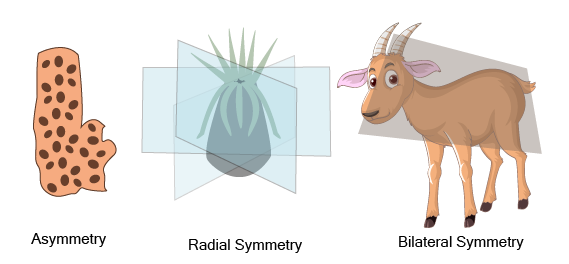
Types of Symmetry
4.1.3 Diploblastic and Triploblastic Organisation
This classification is divided into two categories based on the number of embryonic cell layers:
• Diploblastic: Cells are organized into two embryonic layers, outer ectoderm and inner endoderm, with a middle undifferentiated mesoglea in between. Coelenterates and Sponges, for example.
• Triploblastic: There are three embryonic layers present, namely the outer ectoderm, the middle mesoderm, and the inner endoderm. These three layers are responsible for the formation of all tissues and organs. Ectoderm gives rise to the epidermis and nervous system, for example, while mesoderm gives rise to muscles, endoskeleton, reproductive organs, coelom, and so on, and endoderm gives rise to the alimentary canal, lungs, and so on.
• For example, platyhelminthes
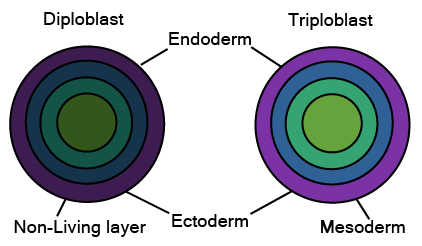
Diploblastic and Triploblastic Organisation
4.1.4 Coelom
The coelom is an animal's fluid-filled body cavity located between the body wall and the digestive tract. On either side of the coelom, mesodermal epithelium lines the space. The coelom contains all of the internal organs. The coelom enhances body flexibility. It is a shock absorber. It protects internal organs from external shocks in soft-bodied animals. It serves as an internal skeleton in some animals. As an example, consider the earthworm.
Animals are classified into three groups based on the nature of their coelom.
• Acoelomates: There is no body cavity, and the coelomic space is occupied by parenchyma-like cells. For instance, Platyhelminthes
• Pseudocoelomates: Animals with a false coelom. The mesodermal epithelium does not form the body cavity. Mesoderm appears as a smattering of pouches between the ectoderm and endoderm. Pseudocoelom develops in these animals from the embryonic cavity known as the blastocoel. As an example, consider Aschelminthes.
• Coelomates or Eucoelomates: Animals that have a true body cavity, such as annelids, mollusks, arthropods, echinoderms, hemichordates, and chordates.
4.1.5 Segmentation
In some animals, the entire length of the body is divided transversely into a number of ring-like parts known as segments. This segmentation phenomenon is known as metamerism.
This pattern can be seen in annelids such as earthworms and arthropods such as millipedes and centipedes. Segmentation aids locomotion in earthworms.
Metameric segments in arthropods can be paired appendages for various functions such as legs for locomotion, antennae for sensory functions, and mouth for feeding, among others.
In insects, these metameric segments form body regions such as the head, thorax, and abdomen.
4.1.6 Notochord
It is a rod-like structure derived from mesoderm that is present dorsally during embryonic development. It is a stiff and flexible tissue rod that runs along the dorsal side of the body, below the nerve cord and above the alimentary canal.
Animals are classified into two groups based on the presence or absence of a notochord.
• Chordates: Animals that have a notochord. The notochord is present in chordates at some point in their lives. For example, fish, birds, mammals, and so on.
• Non-chordates: Animals that lack a notochord. They do not have the notochord at any stage of their life, for example, Porifera to Echinoderms.
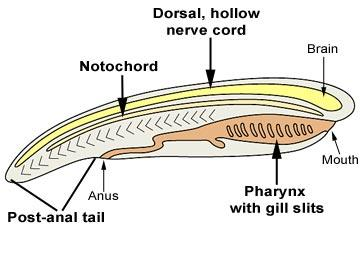
4.2 Classification of Animals
The animal kingdom is divided into three phyla, 11 of which are major phyla and the rest are minor phyla. Invertebrates make up nearly 99 percent of all animals.
Animalia is divided into 11 phyla based on shared fundamental characteristics.
• Porifera
• Coelenterata
• Ctenophora
• Platyhelminthes
• Aschelminthes
• Annelida
• Arthropoda
• Mollusca
• Echinodermata
• Hemichordata
• Chordata.
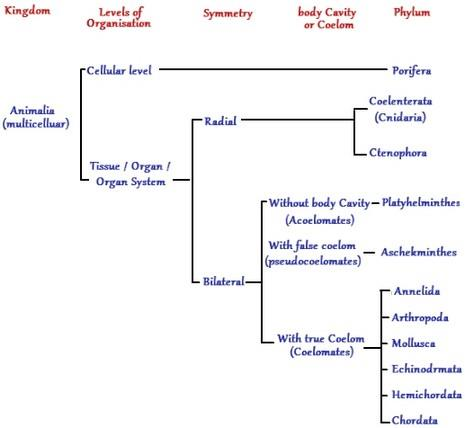
Classification of Animals
4.2.1 Phlyum Porifera
(porus-to-bear; fere-to-bear)
It is the sponges, a group of the most primitive animals.
ELLIS identified these as animals.
ROBERT GRANT coined the term "porifera."
PARAZOOLOGY is the study of sponges.
The majority of them are marine and remain affixed to rocks.
Some people live in freshwater.
Spongilla is a sponge that lives in freshwater.
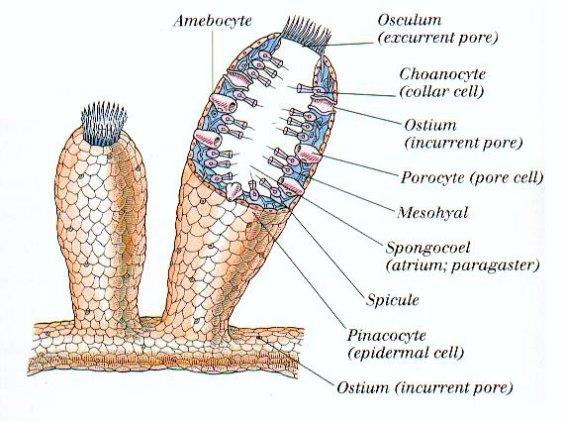
Important characteristic features:
• They live in sedentary habitats and can be solitary or colonial. They are organized at the cellular level. Cells join together to form the body plan.
• The majority of them are asymmetrical, but some are radially symmetrical.
• They are pore-bearing animals, with numerous openings or pores called OSTIA perforating their bodies.
• Body wall: There are two loosely differentiated layers of cells in the body wall. An outer dermal layer of pinacocytes and an inner layer of flagellated cells known as collar cells or choanocytes. They have a diploblastic structure.
• Water transport system (water canal system): The body is a cylinder which envelopes a spongocoel, which is a huge cavity. Spongocoel is accessed through a narrow opening known as the osculum. This pathway aids them in food gathering, respiratory exchange, and waste removal. Ostia or pores (through which water enters) spongocoel (central cavity) osculum or pores (water goes out).
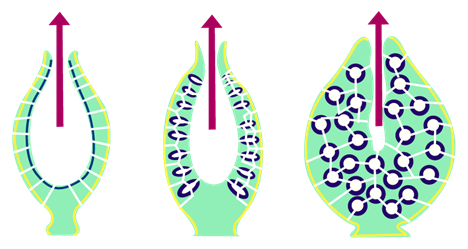
• Choanocytes: Each ostium connects to a canal, which connects to the spongocoel. Choanocytes, which are flagellated collar cells, line the canal. It transports food and oxygen as well as excretory and reproductive waste. Each choanocyte has a long flagellum that protrudes from the free end of the cell. A transparent collar surrounds the lower part of the flagellum. The canal is not well developed in simple sponges. In such cases, the ostia open into the spongocoel via porocytes, and the spongocoel is lined with choanocytes.
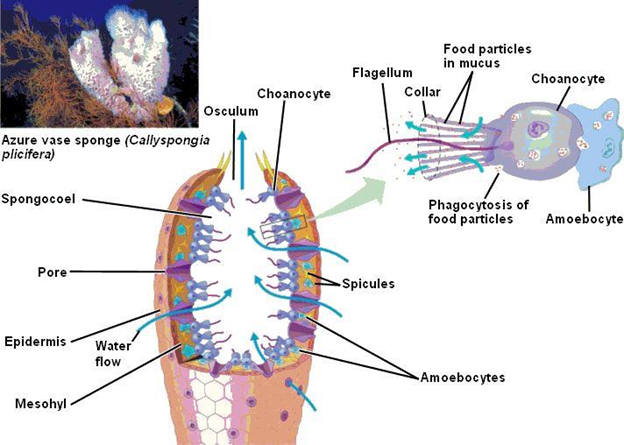
• Mesenchyme is a non-living gelatinous matrix that exists between the two layers of the body. There are amoeboid cells, spicules, and sponging fibers in the mesenchyme. Amoeboid cells: amoeboid cells that move through the matrix carrying food between them. Spicules: These are siliceous or calcareous structures made of silica or calcium carbonate. Sponging fibers are elastic structures made of silk.
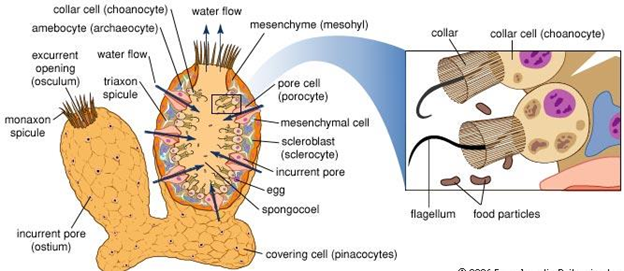
• Spicules and sponging fibers make up the skeleton.
• Sponges are nutritionally holozoic (take solid food). The digestion takes place within the cell.
• Reproductive system: shemaphrodites (sexes are not separate) Reproduces sexually as well as asexually.
Asexual reproduction occurs through fragmentation and budding. During unfavorable conditions, freshwater sponges produce buds known as gemmules, which remain dormant until the next favorable season.
Sexual reproduction: Some amoeboid cells develop into eggs or sperm during sexual reproduction.
Internal fertilization occurs, and larval development occurs indirectly. The zygote develops into a larva after fertilization. Sponge larvae are ciliated and swim freely.
They are classified into two types: amphiblastula and parenchymula.
• All sponges have a high rate of regeneration.
• Examples of Common sponge species may include, Leucosolenia, Sycon (scypha), Euspongia (bath sponge), Spongilla (freshwater sponge), and Eupelectella (venus flower basket).
In Japan, its dried skeleton is given as a costly wedding gift. It is regarded as a symbol of union until death. More examples include Hyalonema (glass rope sponge), Cliona (sulphur sponge), Chalina (dead man finger sponge), and Proterion (neptunes cup).
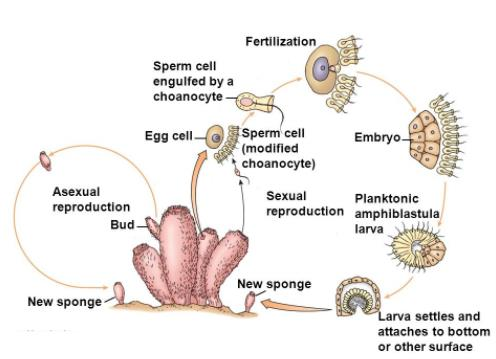
Classification of Porifera
Class I: Calcarea is a type of plant (calcareous sponges. eg: Sypha, Leucosolenia, etc.)
Class II: Demospongia (sponging fiber skeleton. Sponge class with the most members. For example, Euspongia, Spongilla, and so on.
Class III: Hexactinellida (glass sponges with siliceous spicules, such as Euplectella and Hyalonema)
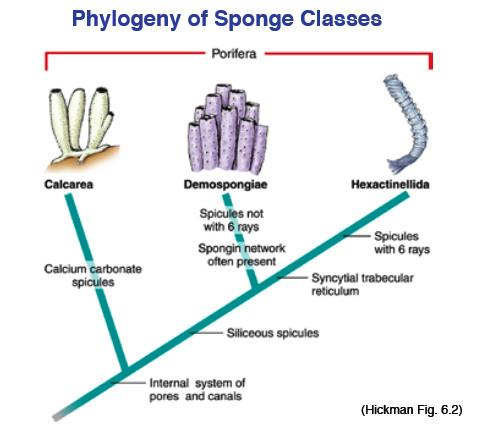
4.2.2 Phylum Coelenterata
Coelenterates or Cnidarians are the common names for animals in the phylum coelenterata. They have true tissues, which makes them more advanced than sponges. It contains approximately 9000 species.
They are aquatic in nature. The majority of them are sea creatures. Hydra is a type of freshwater.
Important Characteristic Features
• They can swim sessile or free.
• They are organized at the tissue level.
• Acoelomates are a type of acoelomate.
• It is radially symmetrical. However, sea anemones are biradially symmetrical.
• Diploblastic body wall (outer ectoderm, inner endoderm and middle mesoglea)
• Body cavity: A central gastro-vascular cavity or coelenteron that exits through the mouth or hypostome. Anus is not present. The body cavity is responsible for both digestion and food circulation. Coelenterates are holozoic and carnivorous eaters.
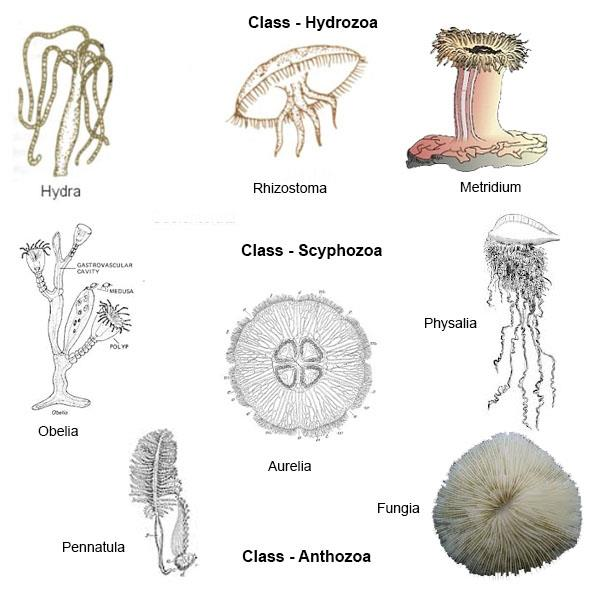
• Digestion occurs both intracellularly and extracellularly. Tentacles are finger-like structures that surround the mouth. It is used for food capture as well as defense.
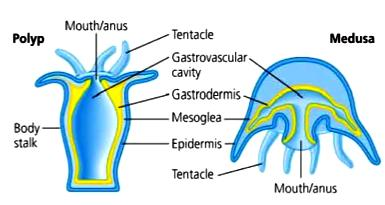
• Cnidoblasts: Cnidaria is derived from the transformation of certain ectodermal cells into stinging cells, cnidodoblasts, or cnidocytes. Each cnidoblast has a stinging capsule called a nematocyst, which contains poisonous fluid. Cnidoblasts are defensive cells that kill or paralyze prey and enemies. They're mostly found on tentacles.
• Physalia's nematocyst poison is a neurotoxin
Polyp: Sedentary, with a tubular body and mouth encircled by a circlet of tentacles It denotes the asexual stage. Hydra and Adamsia are two examples.
Medusa: a free-floating creature with a soft, transparent bell-like body and tentacles on the rim. Like an umbrella. The mouth is located in the center of a concave surface that is directed downward. It symbolizes the sexual stage. Medusa can be thought of as an upside-down polyp. As an example, consider the word Aurelia. The hydra medusa stage does not exist. In the polyp stage, it reproduces sexually.
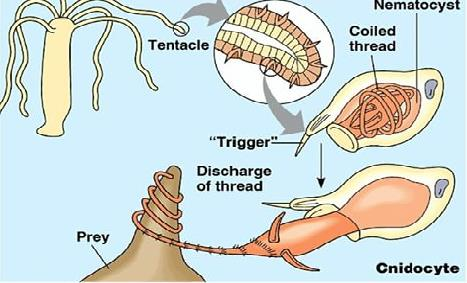
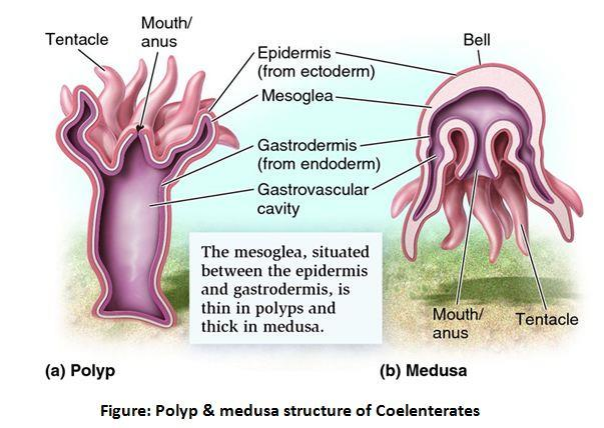
• Reproduction: both asexual and sexual.
Asexual reproduction: It occurs through polyp budding and gives rise to medusa.
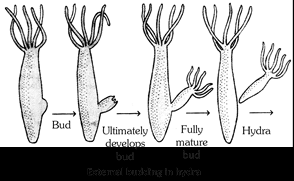
During sexual reproduction, medusa releases gametes into the surrounding water. The zygote develops into a larva after fertilization. Cnidarian larvae are ciliated and swim freely. They are known as planula. The planula transforms into a sessile polyp. Coelenterates exhibit generational alternation throughout their life cycle. Asexual polyp generation alternates with sexual medusa generation in coelenterates that exist in both forms (polyp and medusa). For instance, Obelia
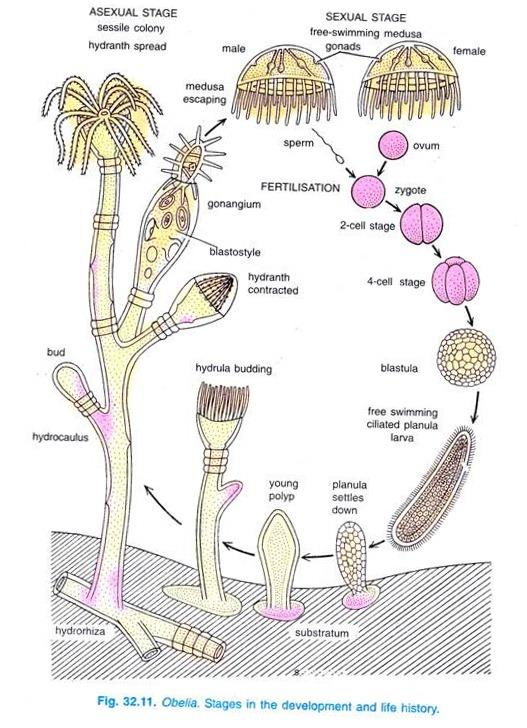
• Polymorphism: This phenomenon is seen in many colonial cnidarians, where the individuals (zooids) of the colony show morphological and functional differentiation. For example, Halistemma and Physalia.
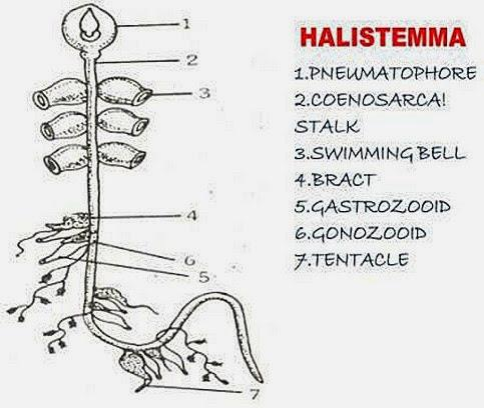
• Common coelenterates include Hydra, Obelia (sea fur), Aurelia (jellyfish), Physalia (portuguese man of war), Adamsia (sea anemone), Vallela (sail by wind), Fungia (mushroom coral), Astraea (star coral), Pennatula (sea pen), Gorgonian (sea fan), Madrepora (stag horn coral), Meandrina
Classification of Coelenterata
Class I: Hydrozoa (both polyp and medusa forms are found). Hydra Obelia, Physalia, and so on)
Class II: Scyphozoa (only the medusa form is found. Aurelia, for example)
Class III: Anthozoa (only the polyp form is found. For example, Adamsia, Fungia, Astraea, Pennatula, Gorgonia, Madrepora, Meandrina, Corallium, and so on.
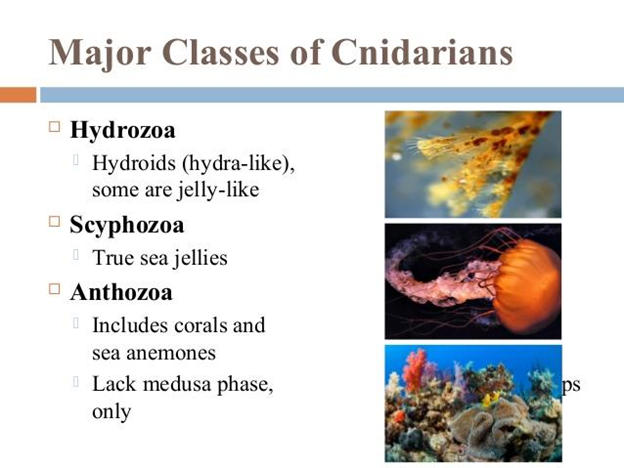
4.2.3 Phylum Ctenophora
(Ktene-bearing; phors-bearing)
Eschololz identified this phylum for the first time in 1928. It only contains a small number of animals (50 species). The animals in this phylum are commonly referred to as sea walnuts or comb jellies.
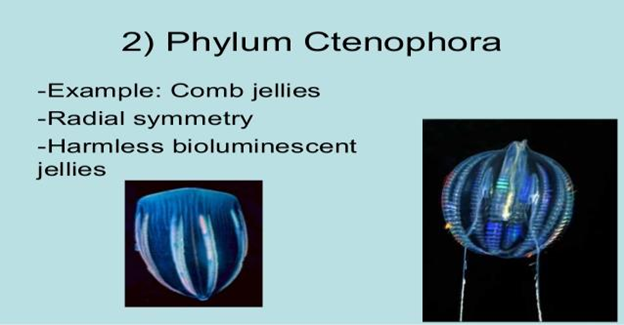
Important characteristic features:
They are either free swimmers or pelagic.
They are sea creatures.
The body is transparent and soft gelatinous.
They are acoelomates with the ability to emit bioluminescence.
Symmetry: They seem to be radially symmetrical (the comb plate arrangement provides the appearance of radial symmetry), while tentacles and gastrovascular cavity branching are symmetrical in both directions. According to some zoologists, it is a biradial symmetry Diploblastic organism with tissue level organization.
Comb plates: the animal's body has eight rows of cilia on the outside. Comb plates are formed when cilia in each row join together. Comb plate ciliary movements aid in locomotion.
Tentacles: A pair of long, retractile tentacles emerge from blind pouches on opposite sides of the body; the tentacles contain colloblast or collocytes that aid in food capture.
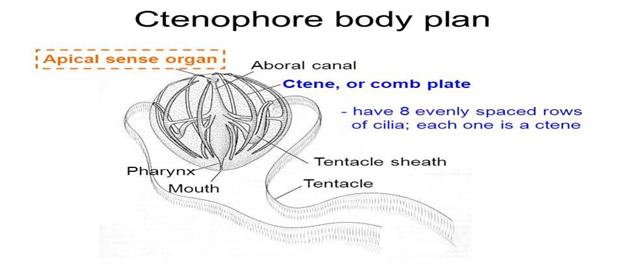
Digestion: It exists on both the extracellular and intracellular levels.
Statocyst: a strange sense organ seen at the opposite end of the mouth It aids in the maintenance of equilibrium.
Reproduction: Only sexually. They are both male and female. Fertilization is done externally. Cydipid larva are in development. Pleurobrachia (sea-gooseberry), Ctenoplana, Cestum (venus girdle), Hormiphora, and Beroe are examples of common ctenophores.
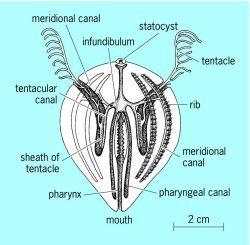
4.2.4 Phylum Platyhelminthes
(Platys-flat; helmins-worms)
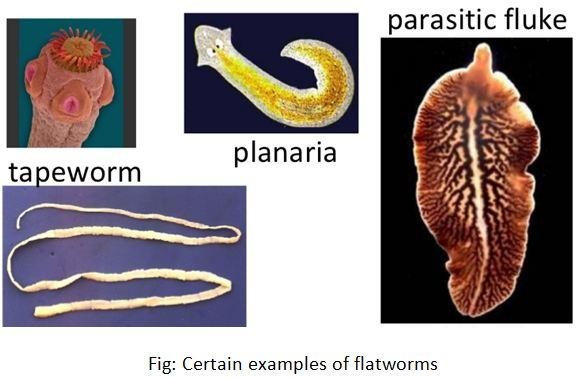
GEGENBAUR was the first to mention Platyhelminthes. They are commonly referred to as flatworms. Today, approximately 13,000 species of flatworms are known. The body is generally flat dorsi-ventrally, hence the name flatworm. This is the first animal group in which the anterior part develops into a head.
Important characteristic features:
• The first animal group to have an organ system level of organization.
• Parasitic adaptations: hooks and suckers are present.
• Bilateral symmetry with dorsal and ventral surfaces The first group of animals with bilateral symmetry.
• Triploblastic animals: these are the first animals to have three germ layers.
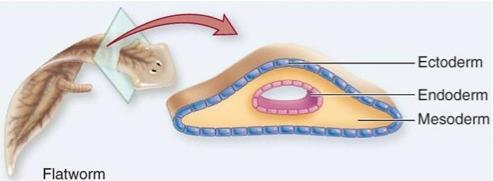
• Acoelomate animals: The space between the body cavity and the alimentary canal is filled with mesoderm-derived loose parenchyma cells (mesenchymal cells).
• Alimentary canal: It has a number of branches. It has a single opening called the mouth that allows it to exit. Anus is not present. The alimentary canal is absent in parasitic flatworms. While living in the host intestine, they absorb nutrients through their body wall.
• Excretory system: it is made up of branching tubes that lead to specialized cells known as flame cells (protonephridia). These cells are responsible for osmoregulation and excretion.
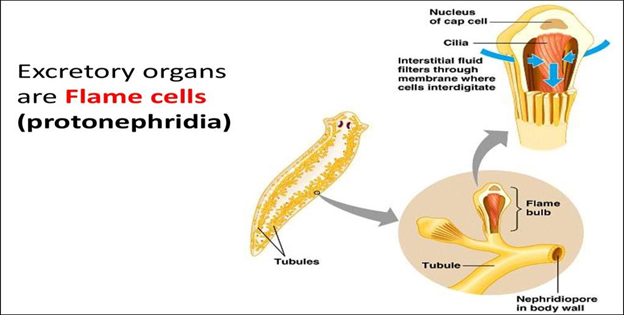
• Reproduction: Hermaphrodites predominate. They can undergo reproduction in both asexual and sexual ways. Asexual reproduction is accomplished through fragmentation and regeneration. Some members have a high capacity for regeneration.
• Fertilisation: It occurs within the body and includes larval stages of development (amphiblastula and parenchymula).
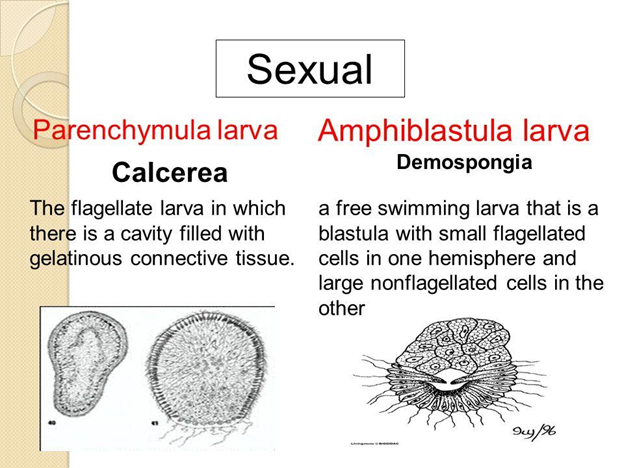
• Tapeworm (Taenia or pork tapeworm), Liver fluke (Fasciola), Blood fluke (Schistosoma), Planaria, and Echinococcus are common examples of flatworms (Dog tapeworm).
Classification of Platyhelminthes
Class I: Turbellaria (free living flatworms, eg : Planaria)
Class II: Trematodes are parasitic worms (ecto or endoparasites with oral and ventral suckers, eg : liver fluke, blood fluke, etc).
Class III: Cestoda (endoparasites with scolex, such as Taenia solium (pork tapeworm), Taenia saginata (beef tapeworm), and others).

4.2.5 Phylum Aschelminthes:
Animals in this phylum are commonly referred to as roundworms, threadworms, bagworms, or nematodes. It contains approximately 15,000 species. Around 15 of these species are human parasites.
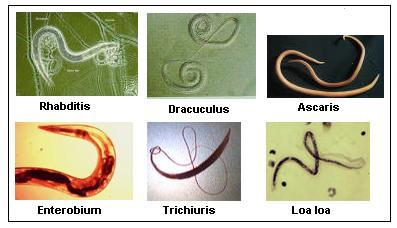
Important characteristic features:
• Whether aquatic or terrestrial, free-living or parasitic in plants and animals.
• Bilaterally symmetrical, triploblastic, pseudocoelomate animals with organ system level.
• Body wall: It is tubular and tapered at both ends, with a thin cuticle covering it.
• The epidermis has multiple nuclei.
• Digestive system: They have a tubular and complete alimentary canal that includes the mouth, muscular pharynx, intestine, and anus. The mouth may have teeth that can cut and pierce the tissues. The muscular pharynx is well developed, assisting in the sucking of food from the host.
• The circulatory and respiratory systems are not present.
• They have a nervous system and exhibit flexible body movements.
• Reproduction: Dioecious, with sexual dimorphism. Males are smaller than females. Copulatory spicules are found in males and aid in the process of copulation.
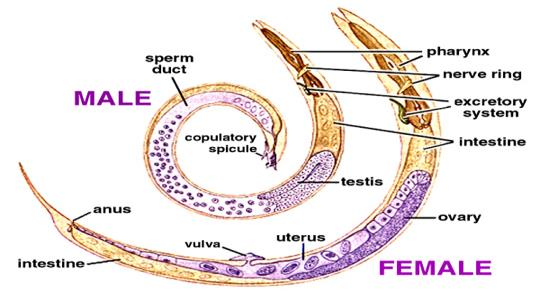
• Fertilization: It is an internal problem. To withstand harsh conditions, the zygote has a thick wall. Development can be either direct or indirect. Parasites in humans are common examples of this phylum, including Roundworms, Hookworms, Filarial worms, Pinworms, and Guinea worms. Other members of this phylum include the eye worm (Loaloa), the whip worm (Trichuristrichura), and the Trichina worm (Trichinella)
4.2.6 Phylum Annelida
(annulus-small ring, lidos-shape)
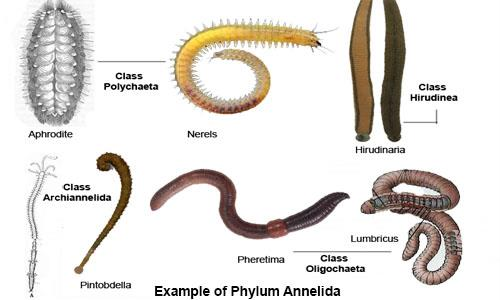
Animals in this phylum are commonly referred to as annelids or segmented worms. Lamarck coined the term "Annelida'' in 1809. There are approximately 9,000 annelid species known today. They come in a variety of shapes and sizes, ranging from 1mm to 2.5m in length.
Important characteristic features:
• They are terrestrial, marine, freshwater, or parasitic, and have organ system-level body organization.
• True coelomates that are bilaterally symmetrical and triploblastic.
• Metamerically segmented: the body is divided into segments called metameres on the outside. The true segmentation of annelids is a remarkable feature.
• A thick cuticle covers the body's surface. Both longitudinal and circular muscles tend to exist in the body wall.
• The organs of locomotion in aquatic annelids, such as Nereis, are setae or unjointed lateral appendages called parapodia, which aid in swimming.
• Digestive system: It is complete and includes the pharynx, oesophagus, stomach, intestine, and other organs.
• Typhlosole: A longitudinal fold in the intestine that increases the surface area available for secretion and absorption.
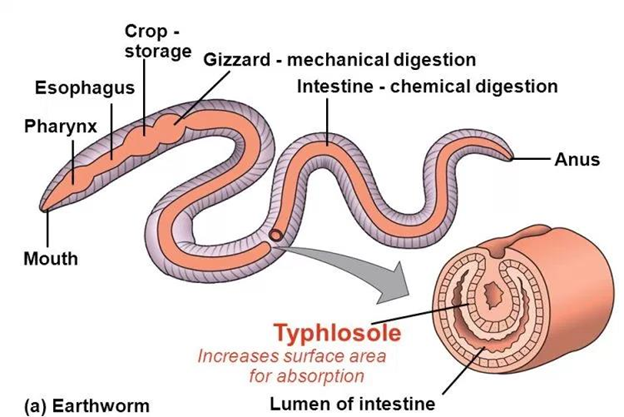
• Chloragogen cells: These are cells found in the cavity of the typhlosole that store food. They produce glycogen and store fat. They also have excretory functions.
• Excretory organs are paired segmentally arranged coiled tubes known as nephridia. They also assist with osmoregulation.
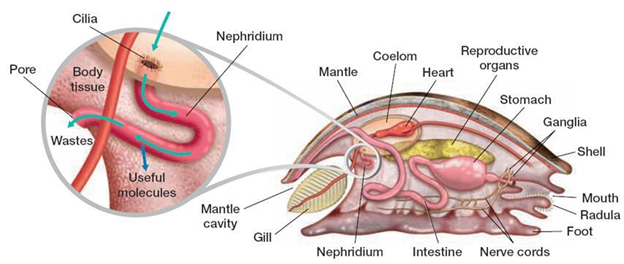
• Circulatory system: It is of the closed variety. Blood flows through a blood vessel that is closed. For the first time in animal evolution, a heart to move the oxygen-carrying blood is discovered.
• They demonstrate skin respiration.
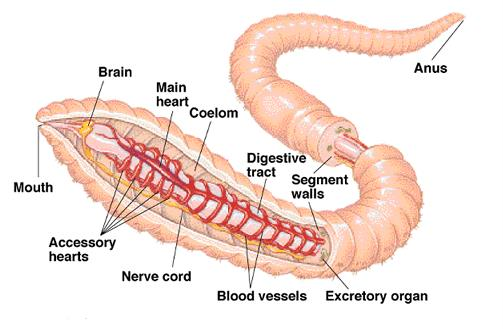
• Nervous system: It is made up of a brain, segmented ganglia, and two ventral nerve cords.
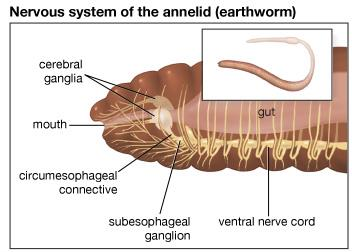
• Reproduction: They have either dioecious or monoecious reproduction. They reproduce in a sexual manner. A trochopore larval stage has been observed in many members.
The common examples of this phylum are:
Pheretima and Megascolex earthworms, Nereis, Hirudinaria (blood sucking leeches), Aphrodite (sea mouse), Tubifex, Chaetopterus, and Terebella
Classification of this phylum:
Class I: Polychaeta (a large number of setae on the parapodia. Nereis, Aphordite, Chaetopterus, and so on)
Class II: Oligochaeta (setae are sparsely distributed throughout the body. As an example, consider the term "Earthworm."
Class III: Hirudinea (no parapodia or setae). There are two suckers present. As an example, consider the term "leech."
Class IV: Archiannelida (no setae or parapodia). Annelids in their primitive state. Polygordius, Bonelia, and others are examples).
4.2.7 Phlum Arthropoda
(poda-appendages; arthros-joint)
They are the animals with appendages and jointed legs. Von Siebold made the first mention of it. It is the animal kingdom's largest phylum. It contains two-thirds of all named animal species on the planet. They first appeared around 600 million years ago. Trilobites are arthropod fossils that lived approximately 600 million years ago.
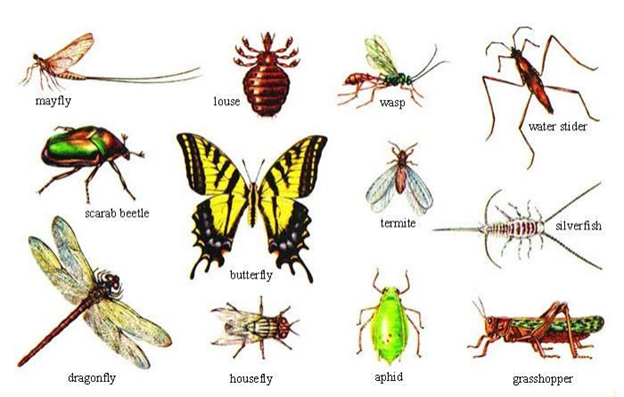
TRILOBITES, the horse-shoe crab, an ancient relative of the Arachinds, can be found in warm estuarine zones such as Bengal's Sunderbans.
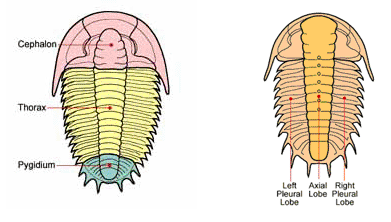
Important characteristic features.
• Their distribution is cosmopolitan. They can be found in freshwater, marine water, on land, and in the air.
• They have two feet that are joined together. They are organized at the organ system level of the body.
• It is symmetrical on both sides.
• They are triploblastic creatures.
• They are segmented creatures.
• They share a dorm room. True coelom is diminished. The body cavity is called haemocoel because it is filled with blood.
• Insects, for example, have a segmented body divided into three regions: head, thorax, and abdomen. In some cases, the head and thorax fuse to form a single region known as the cephalothorax, as in Arachinds, Crustaceans, and so on. Some arthropods, such as myriapods, have only a head and a trunk.
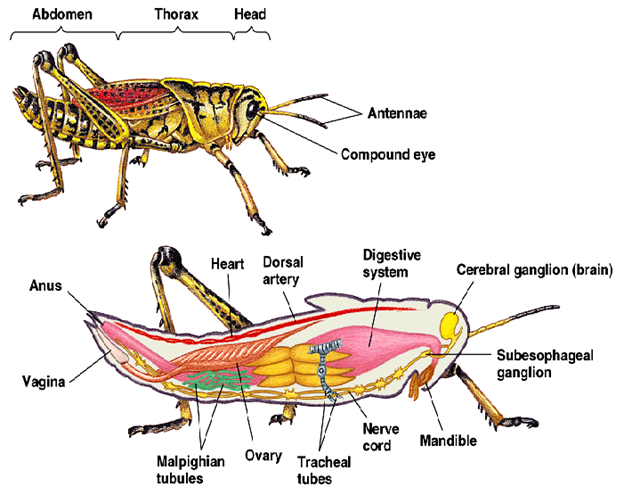
• Exoskeleton: The chitinous jointed exoskeleton covers the entire body. The exoskeleton is light in weight, tough, and made up of proteins and chitin, a polysaccharide that results in a chitinous cuticle. Moulting, also known as ecdysis, is the casting of an old exoskeleton.
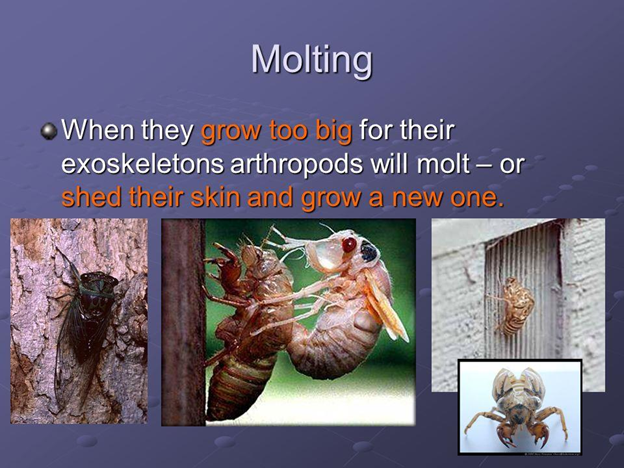
• Podomeres: These organisms have jointed appendages that are differentially modified to perform various functions. Each body segment is equipped with a pair of segmented appendages. Their segments are known as podomeres.
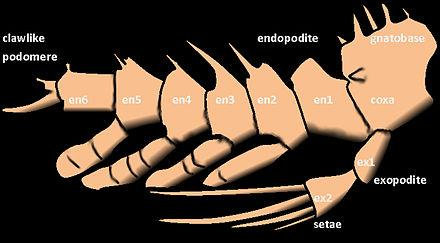
• Circulatory system: It is of the open variety and has a dorsal heart.
• Digestive system: It is fully developed and functional. The mouth is surrounded by mouth parts that have evolved into various types based on the feeding habits of various arthropods.
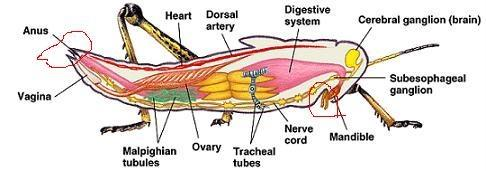
• Respiratory system: In aquatic forms, respiratory organs are gills (e.g., prawn) or gill books (e.g., horseshoe crab), while in terrestrial forms, respiratory organs are book lungs (e.g., scorpion) or tracheal system (e.g., insects).
• Excretion: Green glands or malpighian tubules are excretory organs. There is no nephridia.
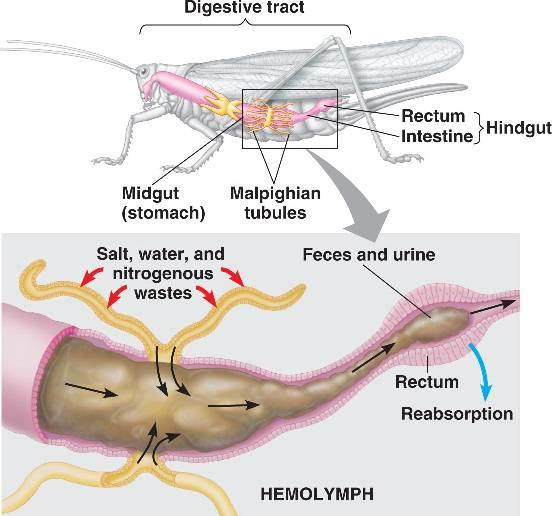
• Cilia is not present.
• The presence of the brain.
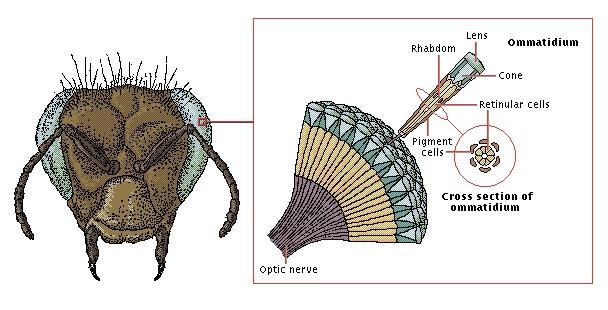
• Sensory organs have matured. Simple or compound eyes are possible. The compound eye is made up of several independent visual units known as ommatidia, each with its own lens. Chirping crickets and cicadas have sound receptors. Many arthropods have feelers called antennae on their heads that allow them to detect odors and sensations of touch. Insects communicate using chemicals known as pheromones.
• Reproduction: most are dioecious. Fertilisation occurs externally in aquatic arthropods and internally in terrestrial arthropods.
• Most arthropods are oviparous. Some of them are viviparous. The eggs hatch within the female and the young are born in such arthropods.
• In many arthropods, development is direct, and juveniles resemble adults. In several insect groups, development occurs in an indirect manner. In such arthropods, the egg hatches into a separate larva that is not related to the adult. The most common arthropods are: Araneus (garden spider), Limulus (king crab), Eupagurus (hermit crab), Cancer, Macrobrachium (prawn), Lepisma (silver fish), Periplanata (cockroach), Apis (bee), Anopheles (mosquito), Musca (housefly), Triops (tadpolefish), Daphnia (water flea), Xensops (Lepas and Balanus)
Classification of phylum Arthropoda:
Class I: Crustacea-Aquatic animals with gills as respiratory organs (eg: prawn, crab, hermit crab, barnacles, etc.)
Class II: Myriaopoda- a terrestrial, air-breathing, multi-legged animal (eg : millipede, centipede, etc)
ClassIII: Arachnids are air-breathing creatures with four pairs of legs (eg: spider, scorpion, king crab, etc.)
Class IV: Insecta – air breathing creatures with three pairs of legs (eg: cockroach, butterfly, Lepisma, Oryctes, Leptocorisa, Musca, Apis silkworm, etc.)
Class V: Onychopora – a terrestrial, air-breathing creature with clawed legs (eg: Peripatus, a living fossil)
4.2.8 Phylum Mollusca
It is the animal kingdom's second largest phylum. Johnston coined the term "mollusca." They have a soft body as well as a shell. Malacology is the study of mollusks, and chonochology is the study of molluscan shells.
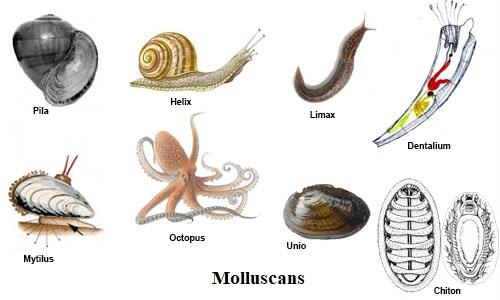
Important characteristic features
• They are mostly aquatic in nature. The majority of them are marine, but some are freshwater and a few are terrestrial. A grey slug is a type of terrestrial mollusk that lacks a shell.
• Molluscs are all soft-bodied, unsegmented animals.
• They have organ system level body organization and are bilaterally symmetrical, with the exception of univalves.
• They are triploblastic creatures.
• They are true coelomates, but the coelom in adults is reduced.
• Their soft body is protected by an unsegmented external shell, which is a haemocoel. The shell is made of calcium carbonate and can be one piece (univalve) or two pieces (dualvalve) (bivalve). In some cases, the shell is internal or not present at all.
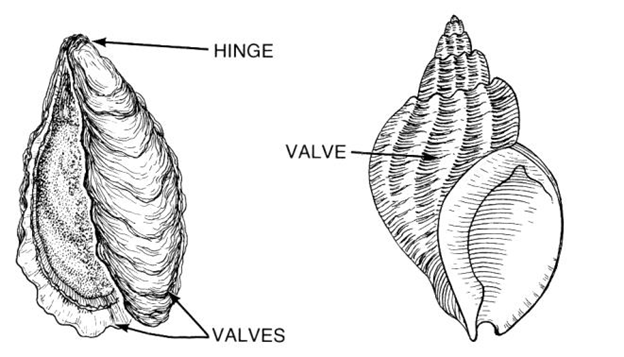
• The body is divided into four sections: the head, mantle, visceral hump, and foot. Sensory tentacles can be found in the head region. The vital internal organs are housed in the visceral hump. It is protected by a soft, spongy layer of skin known as the mantle or pallium. Shell is secreted by the mantle. Gills can be found in the mantle cavity. It has a soft and muscular foot. It is known as the locomotory organ.
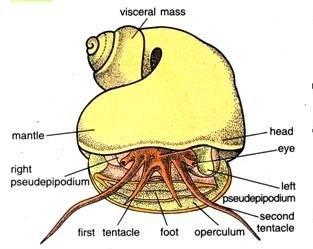
• Digestive system: It is fully developed, complete with salivary glands and a liver.
• The circulatory system is of the open variety. The heart has chambers and is valvular.
• Excretion: Nephridia is present.
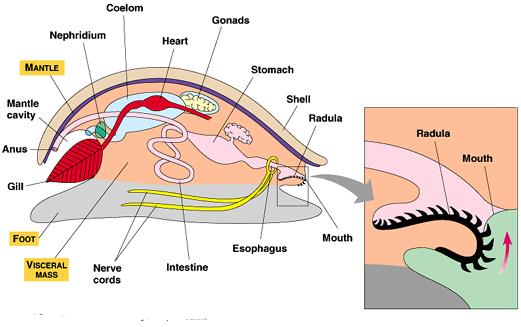
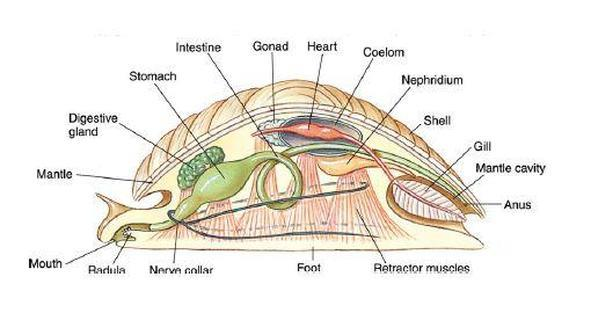
• Nervous system: A network of nerves connects paired ganglia. Tentacles and eyes are examples of sense organs.
• Respiration: Ctenidia (gills) in aquatic forms. Pulmonary sacs in a terrestrial setting.
• Reproduction: Dioecious. Fertilization can be external or internal, oviparous or viviparous. Glochidium, Trocophere, and Veliger are the larval forms. Pila (apple snail), Achatina (land snail), Lamellidens (mussel), Pinctada (pearl oyster), Sepia (cuttlefish), Loligo (squid), and other common molluscans.
Classification
Class I: Polyplacophora- shell made up of 8 pieces. Chilton, for example.
Class II: Monoplacophora- a single-piece shell. As an example, consider the word neopilina.
Class III: Aplacophora-shell is missing. As an example, consider the term neomenia.
Class IV: Tubulr of Scaphopoda. As an example, consider dentalium.
Class V: Pelecypoda- shell in two pieces For example, Mussel, Oyster, Teredo, and so on.
Class VI: Gastropoda- a spirally coiled shell made of one piece. For example, Pila, Snail, Slug, and so on.
Class VII: Cephalopoda- internal or reduced shell. Loligo, Cuttlefish, Devil fish, and so on.
4.2.9 Phylum Echinodermata
(Echinos/spines; derm/skin)
They have a spiny skin or a spiny body. J.Klein coined the term "echinodermata."
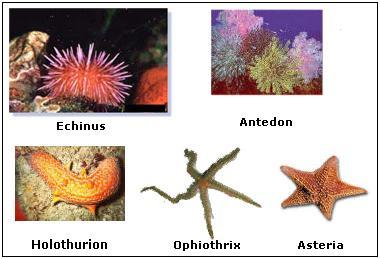
Important characteristic features:
• They are exclusively marine animals.
• The body is covered by a large number of spines, most of which are immovable and serve a protective function, but some spines are movable and aid in locomotion. A few spines are also modified to form defense organs known as pedicellaria. For example, sea urchins, starfish, and so on.
• They have organ system-level body organization. They are triploblastic creatures.
• They are unsegmented and pentamerous in the adult, radially symmetrical, but bilaterally symmetrical in the larval forms.
• They have an endoskeleton made up of calcareous plates called ossicles that are embedded in the skin.
• They are true coelomates, but a large portion of the coelom has been modified to form the water-vascular system, which aids in locomotion, food capture and transport, and respiration.
• A water vascular or ambulacral system in which sea water enters through a porous plate known as madreporite.
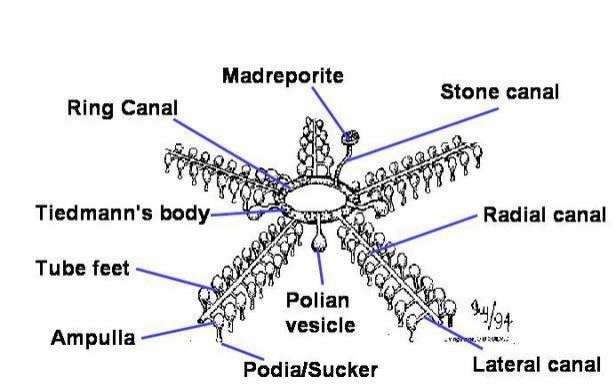
• Tube feet: The water vascular system is made up of radiating canals and tube-like appendages that contain water. Tube feet are the name given to these appendages (podia). Their primary function is locomotion and food capture.
• Digestive system: Includes a mouth on the ventral (lower) side and an anus on the dorsal side (upper side).
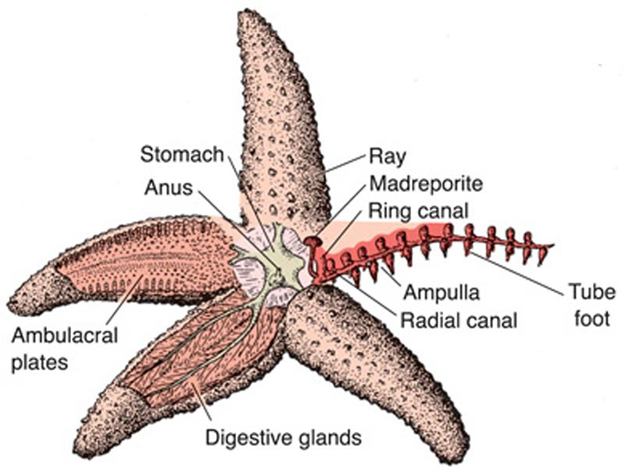
• Respiration: It is carried out by skin gills that protrude from the coelom over the skin.
• Circulatory system: It has been slowed.
• Excretory system: It is not present. Nitrogenous wastes are expelled through the gills.
• Nervous system: It consists of a central nerve ring with radial nerves that extend to each arm.
• Reproduction: Sexes are distinct. External fertilization. The larva develops in an indirect manner as it swims freely.
• Echinoderms have a high capacity for automy and regeneration. Asterias (star fish or sea star), Echinus (sea urchin), Echinocardium (heart urchin), Antedon (feather star or sea silly), Cucumaria (sea cucumber), and Ophiura are the most common echinoderms (brittle star).
Classification of Phylum Echinodermata
Class I: Asteroidean (a star with five arms. As an example, consider the starfish.)
Class II: Ophiuroidea (slender and flexible arms. Brittle fish, for example)
Class III: Echinoidea has no arms and a globular body with long spines. For example, sea urchin)
Class IV: Holothuroidea (armless, long body with long spines. For example, sea cucumber)
Class V: Crinoidea (slender, forked arms with branches. As an example, consider the sea lily.)
4.2.10 Phylum Hemichordata :
Have small worm-like sea creatures. Previously classified as a sub-phylum of Phylum Chordata.
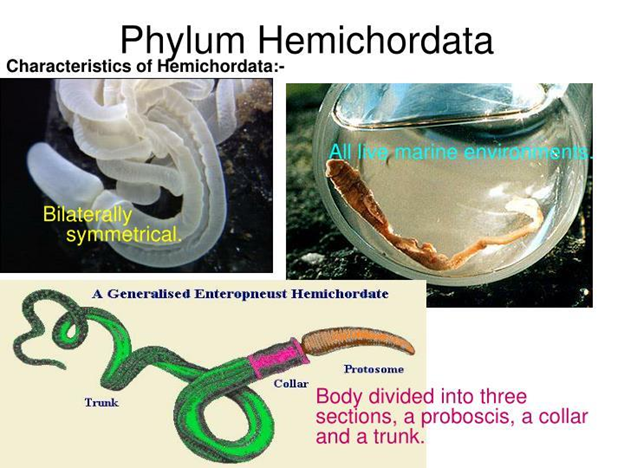
Triploblastic, bilaterally symmetrical, and coelomate. The body is cylindrical, with a proboscis, collar, and trunk. The circulation is of the open type. Respiration via the gills Proboscis gland excretion The sexes are distinct. Fertilization from outside sources Development that is done indirectly. Balanoglossus and Saccoglossus are two examples.
4.2.11 Phylum Chordata:
The presence of a Notochord (between gut and nerve cord) Have a hollow nerve chord on the dorsal side. There are two pharyngeal gill slits. The heart is located ventral. There is a postanal tail present. Organ system level of organization is bilaterally symmetrical, triploblastic, and coelomate. Circulation is of the closed variety. The distinctions between Chordata and Non-chordata are shown below.
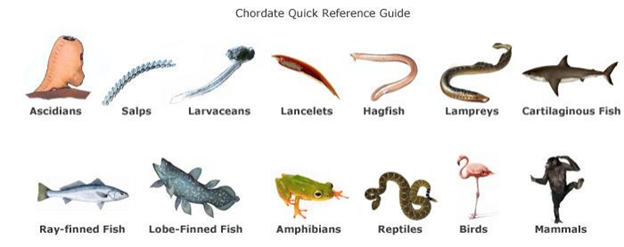
Chordata | Non-Chordata |
1. Notochord is present in the embryonic stage. | Notochord is absent in the embryoonic stage. |
2. Central nervous system is hollow, dorsal and single. | Central nervous system is ventral, solid and double |
3. Slits of pharyngeal gill are present. | Pharyngeal gill slits absent. |
4. Ventral heart | Dorsal heart |
5. Post-anal tail present | Post anal tail absent |
Chordata
1. Notochord is found in the embryonic stage Absent
2. Central nervous system is dorsal, hollow and single Ventral, solid and double
3. Pharyngeal gill slits present Absent
4. Ventral heart Dorsal heart (if present)
5. Post-anal tail present Absent
The phylum Chordata is divided into three sections:
1.Urochordata or Tunicata,
2.Cephalochordata,
3.Vertebrata.
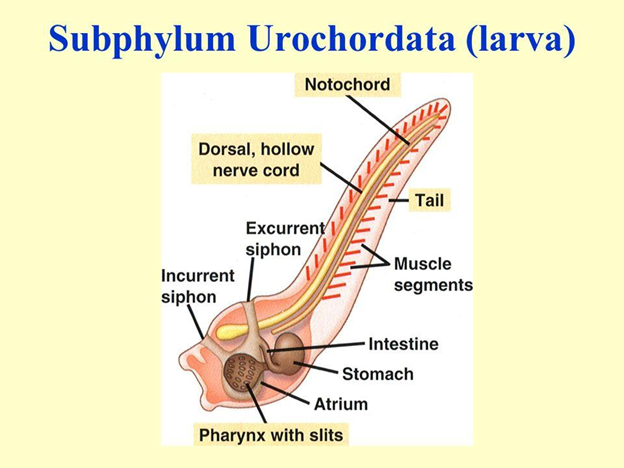
Sub-Phyla Urochordata:
The notochord is only found in the larval stage's tail. The body is covered by test or a tunic made entirely of tunicin. Metamorphosis that regresses Ascidia, Salpa, and Doliolium are examples of hermaphrodites.
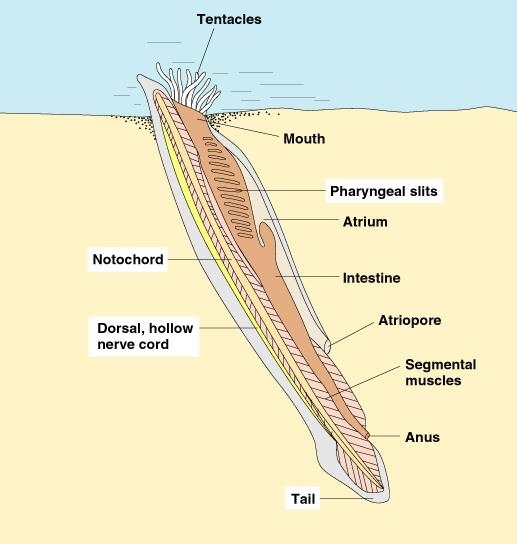
Subphylum Cephalochordata:
The segmented notochord is a persistent structure that extends from head to tail. The body has a pharynx-like sac with gill slits for filter feeding and respiration. Fish-like only in the sea There is no clear coelom. The sexes are distinct. Branchiostoma, for example (Amphioxus or Lancelet)
Sub-Phyla Vertebrata:
Only during the embryonic period do you have a notochord. The notochord is replaced by the vertebral column, which can be bony or cartilaginous. A ventral muscular heart with two, three, or four chambers is preferred. Fins or limbs with paired appendages. Kidneys are responsible for excretion and osmoregulation.
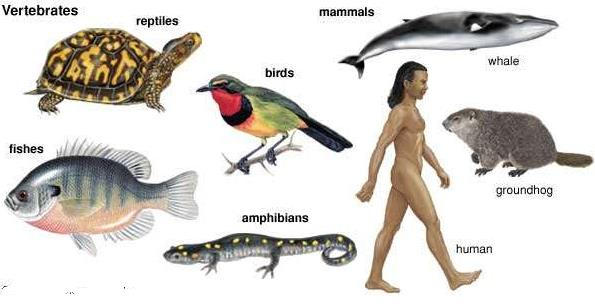
Vertebrata: Agnatha and Gnathostomata are the two divisions. Agnatha (Toothless): There is one class included: Cyclostomata
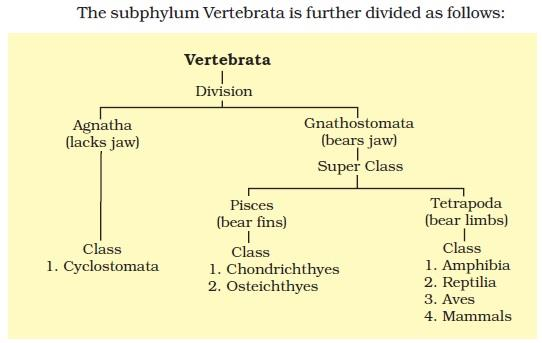
4.2.11.1 Class: Cyclostomata:
Suction and a circular mouth without jaws Some fishes host ectoparasites. There are no scales and no paired fins. The cranium and spinal column are cartilaginous. Although it lives in the sea, it migrates to freshwater to spawn and dies afterward. After metamorphosis, larvae of Petromyzon (Lamprey) and Myxine return to the ocean (Hagfish).
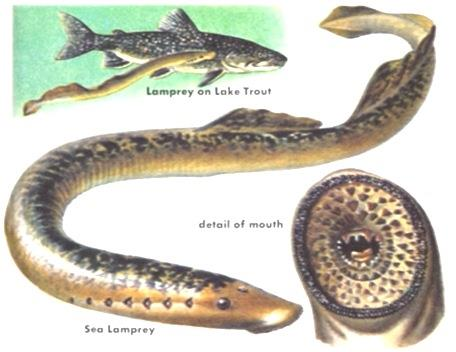
Division Gnathostomata (Bear Jaws)
SUPER-CLASS: PISCES
4.2.11.2 Class 1: Chondrichthyes :
Marine animals that have a stream-lined body and a cartilaginous endoskeleton. The mouth is located ventrally. The notochord is present throughout life. Gill slits are distinct and lack an operculum. The skin is covered in placoid scales. Teeth are modified placoid scales found in the jaw. Predaceous in most cases. There is no swim bladder. The heart has two chambers. (One auricle and one ventricle) certain of them possess electric organs (for example, Torpedo) and few carry poison stings. (For example, Trygon) Poikilotherms are people who are cold-blooded. Dioecious. The male's pelvic fin bears claspers, indicating sexual dimorphism. Internal fertilization. Many are viviparous. Torpedo (Electric ray) and Rhinobatus are two examples (Guitar fish).
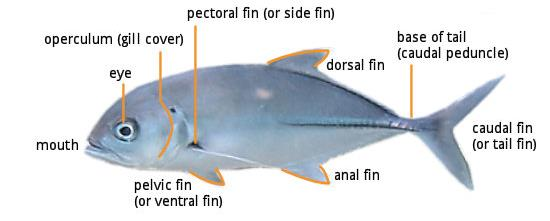
4.2.11.3 Class 2: Osteichthyes:
Fish from both salt and freshwater are included. Endoskeleton made of bone. Usually, the mouth is the last stop. The operculum covers four pairs of gill slits. Scales on the skin are cycloid/ctenoid. For buoyancy, an air bladder is present. The heart has two chambers. Animals with cold blood. Dioecious. Monomorphic in both sexes. Fertilization is done externally. The majority of them are oviparous. Development is a two-way street. Exocoetus (flying fish) and Hippocampus are two marine examples (Sea horse). Labeo (freshwater) (Rohu). Clarias, Catla (Katla) (Magur). Betta (fighting fish) aquarium, Pterophyllum (Angel fish).
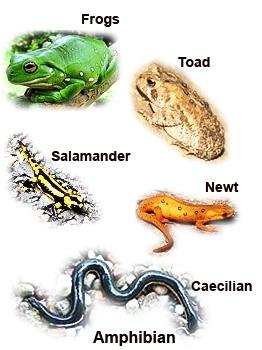
SUPER CLASS: TETRAPODA –
4.2.11.4 Class-1: Amphibia
It is a type of terrestrial tetrapod that lives in both water and on moist land because the skin lacks protective scales and the larval stage is aquatic. The creature has two pairs of jointed pentadactyl limbs. Their digits lack claws, nails, and hoofs. The body is categorised into two major parts: the head and the trunk. Skin that is moist and free of scales. Tympanum is a symbol for the ear. The cloaca is the common chamber through which the alimentary, urinary, and reproductive tracts emerge. Respiration via the gills, lungs, or skin Cold blooded animals have a three-chambered heart (two auricles and one ventricle). The sexes are separated. Fertilization is an external process that necessitates the use of water. Indirect development, oviparous. Ichthyophis, Necturus, Siren, Amphiuma, Salamandra, Rana, Bufo, Hyla, and other genera are examples.
4.2.11.5 Class - 2: Reptilia
The crawling or creeping mode of locomotion. The skin on the body is dry and cornified, with epidermal scales or scutes. Tympanum is a symbol for the ear. When limbs are present, they are in pairs. Crocodiles have a four-chambered heart, which is unusual for a three-chambered heart. Scales shed by snakes and lizards as skin cast. Poikilotherm. The sexes are distinct. Internal fertilization occurs. Direct development, oviparous. Chelone (Turtle), Testudo (Tortoise), Chameleon (Tree lizard), Calotes (Garden lizard), Crocodilus (Crocodile), Alligator (Alligator), Hemidactylus (Wall lizard), Poisonous Snakes – Naja (Cobra), Bangarus (Krait), Vipera (Wall lizard) (Viper).
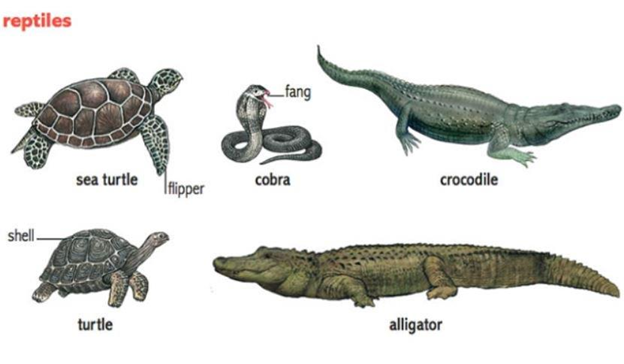
4.2.11.6 Class - 3: Aves
The presence of feathers, and the majority of them fly, with the exception of flightless birds such as the ostrich. Jaws reshaped to form a beak with no teeth. Wings are formed from the forelimbs. Scales cover the hind limbs. Except for an oil gland at the base of the tail, there are no glands on the skin. The endoskeleton has nearly completely ossified. Spongy or pneumatic bones Long bones are hollow and contain air cavities. There are no epiphyses. The skull has a monocondylic shape. The digestive tract contains additional chambers such as the crop and gizzard. The heart has four chambers. Homoiothermous, or warm-blooded, with the ability to maintain a constant body temperature. To supplement respiration, air sacs are connected to the lungs. Oviparous. Direct advancement. Examples include pigeons, crows, sparrows, and peacocks.
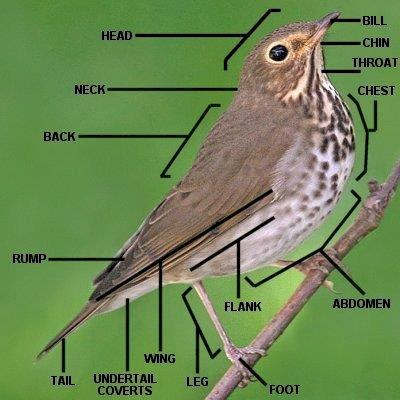
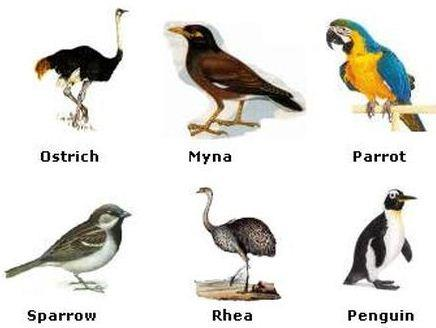
4.2.11.7 Class- 4: Mammalia
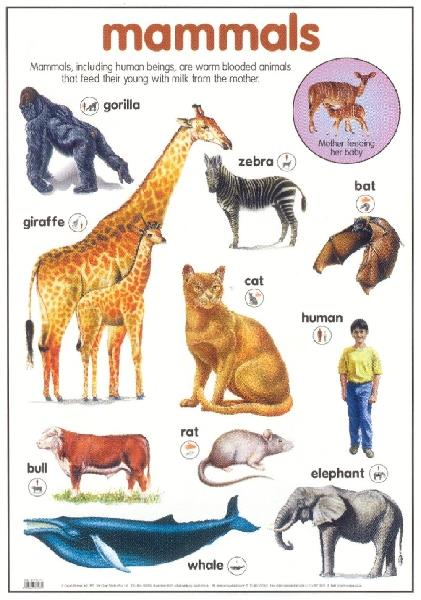
Mammary glands secrete milk to nourish young ones. You have two sets of limbs. Hairs can be found on skin. There are external ears or a pinna present. Jaw teeth come in a variety of shapes and sizes. The heart has four chambers. Homoiothermous. Respiration via the lungs. Sexes separate, and fertilization occurs internally. It is either viviparous or oviparous. Direct advancement. Examples: Ornithorhynchus ovary-Ornithorhynchus ovary-Ornithorhynchus (Platypus). Viviparous - Macropus (Kangaroo), Camelus (Camel), Pteropus (Flying Fox), Rattus (Rat), Macaca (Monkey), Felis (Cat), Canis (Dog), Equus (Horse), Elephas (Elephant), Balaenoptera (Blue whale), Delphinus (Common dolphin), Panthera leo (Tiger), Panthera tigris (Tiger), Panther (Lion).
Importance of Animal Kingdom Class 11 Notes
Understanding the basics of living organisms, their classification, and taxonomy is crucial for advanced biology topics.
Class 11 Animal Kingdom Notes provide a clear introduction to key concepts that will be built upon in subsequent chapters.
The notes break down complex concepts such as animal classification, major phyla, and evolutionary relationships into easy-to-understand points.
With summaries and key facts, Class 11 Biology Chapter 4 Notes are ideal for quick revision before exams.
The notes include clear explanations, examples, and diagrams that help in a better understanding of the living world, making it easier for students to connect theoretical concepts with practical examples.
By covering crucial topics and providing important details, Class 11 Biology Animal Kingdom Notes helps students prepare thoroughly for exams.
Tips for Learning the Class 11 Biology Chapter 4 Animal Kingdom
Start by grasping how animals are classified into different phyla. Pay attention to the key characteristics that differentiate each group.
Review the main phyla, including Porifera, Cnidaria, Platyhelminthes, Nematoda, Annelida, Arthropoda, Mollusca, and Echinodermata. Learn their distinct features and examples of animals within each phylum.
Visual images can help improve your understanding of animal classifications and their evolutionary relationships. Create or review diagrams to see how different groups are related.
Break down complex topics like evolutionary significance and anatomical features into simpler summaries. This can make it easier to remember and review key points.
Work through examples of animals from each phylum to solidify your understanding. Try to identify their characteristics and classification criteria.
Conclusion
Animal Kingdom Class 11 Notes simplify key concepts like animal classification, major phyla, and evolutionary traits. By breaking down complex ideas into clear points and using helpful diagrams, these notes make it easier to understand and remember important information. Reviewing Animal Kingdom Notes regularly will improve your confidence and help you perform well in exams. With a solid grasp of the Animal Kingdom, you’ll be well-prepared for any questions on this topic.
Animal Kingdom Chapter Related Important Study Materials
It is a curated compilation of relevant online resources that complement and expand upon the content covered in a specific chapter. Explore these links to access additional readings, explanatory videos, practice exercises, and other valuable materials that enhance your understanding of the chapter's subject matter.
S.No | Animal Kingdom Related Other Study Materials |
1 | |
2 | |
3 |
Chapter-wise Class 11 Biology Notes PDF Download
S. No | Chapter wise Class 11 Biology Revision Notes |
1 | |
2 | |
3 | |
4 | |
5 | |
6 | |
7 | |
8 | |
9 | |
10 | |
11 | |
12 | |
13 | |
14 | |
15 | |
16 | |
17 | |
18 |
Related Study Materials Links for Class 11 Biology
S. No | Related Study Materials Links for Class 11 Biology |
1. | |
2. | |
3. | |
4. | |
5. | CBSE Class 11 Biology Sample papers |
6. |
FAQs on Animal Kingdom Class 11 Biology Chapter 4 CBSE Notes - 2025-26
1. What are the key levels of organisation to remember for a quick summary of the Animal Kingdom?
For a quick revision of the Animal Kingdom, it's essential to recall the four main levels of organisation. These levels show the increasing complexity of animal body plans: Cellular Level (e.g., Sponges), Tissue Level (e.g., Coelenterates), Organ Level (e.g., Platyhelminthes), and Organ System Level (e.g., Annelids, Arthropods, Mammals). Understanding this progression is a core concept for the chapter.
2. For a quick revision, why is understanding an animal's symmetry and coelom type so important?
Understanding symmetry and the coelom is crucial for revision because they are fundamental concepts used to classify and differentiate major animal groups. Symmetry (asymmetrical, radial, or bilateral) provides a quick clue about an animal's lifestyle and nervous system. The coelom (body cavity) is a key feature that reflects the complexity of internal organs. Knowing if an animal is an acoelomate, pseudocoelomate, or coelomate helps to quickly place it within the correct phylum and understand its evolutionary standing.
3. What are the main characteristics to remember for a quick summary of Phylum Porifera?
For a quick summary of Phylum Porifera (sponges), focus on these key terms: They have a cellular level of organisation and are generally marine and asymmetrical. The most distinctive feature is the water canal system, which helps in food gathering, respiration, and waste removal. Their body is supported by a skeleton made of spicules or spongin fibres. Examples like Sycon and Spongilla are useful to remember.
4. How can one summarise the key features of Phylum Ctenophora for quick revision?
To quickly revise Phylum Ctenophora (sea walnuts or comb jellies), remember these points: They are exclusively marine, radially symmetrical, and have a tissue-level organisation. Their most defining feature is the presence of eight external rows of ciliated comb plates, which aid in locomotion. Many Ctenophores also exhibit bioluminescence, the property of a living organism to emit light. Unlike Cnidarians, they typically do not have cnidoblasts.
5. What is the main evolutionary concept to remember that separates diploblastic from triploblastic animals?
The key concept separating diploblastic and triploblastic animals is the number of embryonic germ layers. Diploblastic animals (like Cnidaria) have two layers: an external ectoderm and an internal endoderm. Triploblastic animals (from Platyhelminthes to Chordates) have a third layer, the mesoderm, between the ectoderm and endoderm. The evolution of the mesoderm was a major step, as it allowed for the development of true organs and more complex body structures.
6. How can a concept map of key features help in a quick revision of Chordates versus Non-chordates?
A concept map is an excellent tool for revising Chordates vs. Non-chordates. The central idea would be the presence or absence of the notochord. For Chordates, branch out to list the other three core features: a dorsal hollow nerve cord, pharyngeal gill slits, and a post-anal tail. For Non-chordates, you can create branches for key contrasting features like a ventral nerve cord (if present), absence of a notochord, and different circulatory systems. This visual summary helps in rapid recall during exams.
7. What are the key characteristics of Phylum Arthropoda that are essential for a chapter summary?
For any summary of the Animal Kingdom, Phylum Arthropoda is critical as it is the largest phylum. The key features to remember are: the presence of a chitinous exoskeleton, which requires moulting for growth, and jointed appendages, which are modified for various functions. They have an open circulatory system and their body is typically divided into a head, thorax, and abdomen. Remembering these three core concepts provides a solid summary of the phylum.
8. How are the key features of Class Mammalia, such as the presence of a four-chambered heart and mammary glands, summarised in these notes?
The summary of Class Mammalia focuses on its most unique and defining characteristics. The key features highlighted are the presence of mammary glands for nourishing young ones and hair or fur on their skin. They are warm-blooded (homoiothermous) and possess a highly efficient four-chambered heart. These notes present these points concisely to help you quickly differentiate mammals from other vertebrate classes like Reptilia and Aves.


















